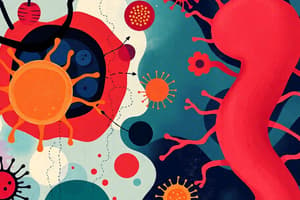Podcast
Questions and Answers
What is a rare infection site for microfilariae in the body?
What is a rare infection site for microfilariae in the body?
Arms and breasts.
What is a common location for infections caused by microfilariae?
What is a common location for infections caused by microfilariae?
Lower limbs and genitalia.
What condition is associated with tropical pulmonary eosinophilia?
What condition is associated with tropical pulmonary eosinophilia?
Diffuse filarial lung disease.
What triggers tropical pulmonary eosinophilia?
What triggers tropical pulmonary eosinophilia?
How does tropical pulmonary eosinophilia affect the pulmonary vascular system?
How does tropical pulmonary eosinophilia affect the pulmonary vascular system?
What type of lung disease is characterized by diffuse interstitial involvement?
What type of lung disease is characterized by diffuse interstitial involvement?
What role do microfilarial antigens play in the infection process?
What role do microfilarial antigens play in the infection process?
Which areas of the body are least likely to experience microfilariae infections?
Which areas of the body are least likely to experience microfilariae infections?
What are the primary pathogenic mechanisms of this disease?
What are the primary pathogenic mechanisms of this disease?
How do microfilariae contribute to the disease's pathogenicity?
How do microfilariae contribute to the disease's pathogenicity?
What type of inflammation is associated with the microfilariae in this disease?
What type of inflammation is associated with the microfilariae in this disease?
What organs are primarily affected by granulomatous inflammation linked to this disease?
What organs are primarily affected by granulomatous inflammation linked to this disease?
In the context of this disease, how does granulomatous inflammation manifest?
In the context of this disease, how does granulomatous inflammation manifest?
What conclusion can be drawn regarding the pathogenicity of microfilariae?
What conclusion can be drawn regarding the pathogenicity of microfilariae?
Discuss the role of adult forms in the disease's pathogenic mechanisms.
Discuss the role of adult forms in the disease's pathogenic mechanisms.
How might understanding the role of granulomatous inflammation in this disease aid in treatment?
How might understanding the role of granulomatous inflammation in this disease aid in treatment?
What are some common symptoms associated with lymphadenitis?
What are some common symptoms associated with lymphadenitis?
What hematological changes are typically observed in lymphadenitis?
What hematological changes are typically observed in lymphadenitis?
How does fibrosis contribute to chronic obstructive manifestations?
How does fibrosis contribute to chronic obstructive manifestations?
What specific complications arise from lymphatic obstruction due to fibrosis?
What specific complications arise from lymphatic obstruction due to fibrosis?
What is the role of coiled worms in lymphatics concerning inflammation?
What is the role of coiled worms in lymphatics concerning inflammation?
How might lymphadenitis symptoms differ in the groin compared to other regions?
How might lymphadenitis symptoms differ in the groin compared to other regions?
What is the significance of eosinophilia in the context of lymphadenitis?
What is the significance of eosinophilia in the context of lymphadenitis?
Describe how endothelial proliferation is related to chronic obstructive manifestations.
Describe how endothelial proliferation is related to chronic obstructive manifestations.
Flashcards are hidden until you start studying
Study Notes
Pathogenic Mechanisms
- Pathogenic mechanisms primarily involve adult worms; microfilariae typically lack direct pathogenic effects.
- Microfilariae are linked to granulomatous inflammation in the lungs, liver, and spleen.
Common Infection Sites
- Infection commonly affects lower limbs and genital regions, including scrotum, penis, and vulva.
- Rarely seen in arms and breasts.
Tropical Pulmonary Eosinophilia
- Result of the host's hyper-responsiveness to microfilarial antigens.
- Causes local destruction of microfilariae within the pulmonary vascular system, leading to diffuse interstitial lung disease.
- Symptoms include lymphadenitis, particularly in the groin and axilla.
Symptoms
- Key symptoms include fever, chills, headache, vomiting, and malaise.
- Laboratory findings often reveal leucocytosis and eosinophilia.
Chronic Obstructive Manifestations
- Chronic obstruction arises from fibrosis due to ongoing inflammation.
- Presence of coiled worms within lymphatics leads to endothelial proliferation.
Consequences of Obstruction
- Results in dilatation of lymphatics, causing varicosities, especially in genital organs.
- Associated conditions include hydrocele and scrotal lymphoedema.
- Abdominal wall varicosities may also occur.
Studying That Suits You
Use AI to generate personalized quizzes and flashcards to suit your learning preferences.




